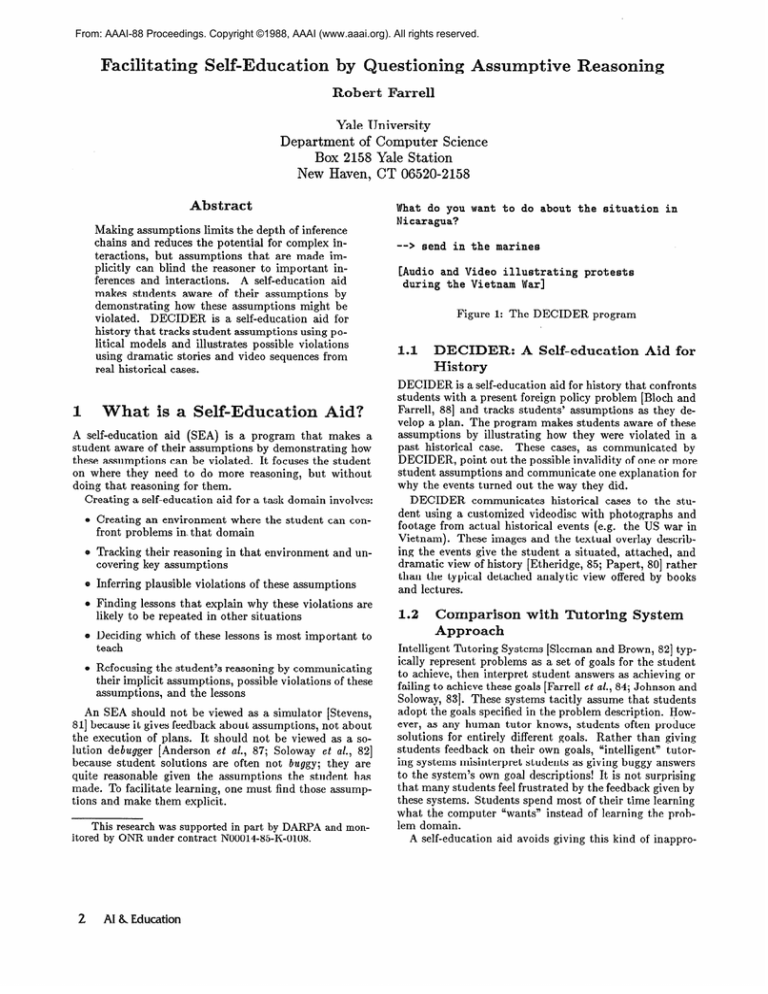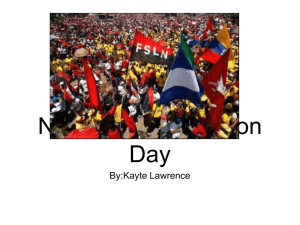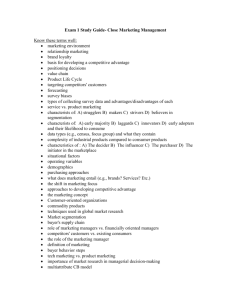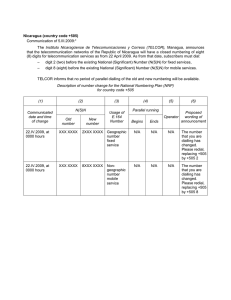
From: AAAI-88 Proceedings. Copyright ©1988, AAAI (www.aaai.org). All rights reserved.
Facilitating
Self-Education
by Questioning
Assumptive
Reasoning
Robert Farrell
Yale University
Department of Computer Science
Box 2158 Yale Station
New Haven, CT 06520-2158
Abstract
Making assumptions limits the depth of inference
chains and reduces the potential for complex interactions, but assumptions that are made implicitly can blind the reasoner to important inferences and interactions.
A self-education aid
makes students aware of their assumptions by
demonstrating how these assumptions might be
violated. DECIDER is a self-education aid for
history that tracks student assumptions using political models and illustrates possible violations
using dramatic stories and video sequences from
real historical cases.
1
What
is a Self-Education
Aid?
A self-education aid (SEA) is a program that makes a
student aware of their assumptions by demonstrating how
these assumptions can be violated. It focuses the student
on where they need to do more reasoning, but without
doing that reasoning for them.
Creating a self-education aid for a task domain involves:
Creating an environment where the student can confront problems in, that domain
Tracking their reasoning in that environment and uncovering key assumptions
Inferring plausible violations of these assumptions
Finding lessons that explain why these violations are
likely to be repeated in other situations
Deciding which of these lessons is most important to
teach
Refocusing the student’s reasoning by communicating
their implicit assumptions, possible violations of these
assumptions, and the lessons
An SEA should not be viewed as a simulator [Stevens,
811 because it gives feedback about assumptions, not about
the execution of plans. It should not be viewed as a solution debugger [Anderson et al., 87; Soloway et al., 821
because student solutions are often not buggy; they are
quite reasonable given the assumptions the student has
made. To facilitate learning, one must find those assumptions and make them explicit.
This research was supported in part by DARPA
itored by ONR under contract N00014-85-K-0108.
2
AI 8. Education
and mon-
What do you want to do about
Nicaragua?
-->
the situation
in
send in the marines
[Audio and Video illustrating
during the Vietnam War]
protests
Figure 1: The DECIDER program
I.1
DECIDER:
History
A Self-education
Aid for
DECIDER is a self-education aid for history that confronts
students with a present foreign policy problem [Bloch and
Farrell, 881 and tracks students’ assumptions as they develop a plan. The program makes students aware of these
assumptions by illustrating how they were violated in a
past historical case. These cases, as communicated by
DECIDER, point out the possible invalidity of one or more
student assumptions and communicate one explanation for
why the events turned out the way they did.
DECIDER communicates historical cases to the student using a customized videodisc with photographs and
footage from actual historical events (e.g. the US war in
Vietnam). These images and the textual overlay describing the events give the student a situated, attached, and
dramatic view of history [Etheridge, 85; Papert, 801 rather
than the typical detached analytic view offered by books
and lectures.
arison with Tutoring System
Approach
Intelligent Tutoring Systems [Sleeman and Brown, 821 typically represent problems as a set of goals for the student
to achieve, then interpret student answers as achieving or
failing to achieve these goals [Farrell et al., 84; Johnson and
Soloway, 831. These systems tacitly assume that students
adopt the goals specified in the problem description. However, as any human tutor knows, students often produce
solutions for entirely different goals. Rather than giving
students feedback on their own goals, “intelligent” tutoring systems misinterpret students as giving buggy answers
to the system’s own goal descriptions! It is not surprising
that many students feel frustrated by the feedback given by
these systems. Students spend most of their time learning
what the computer “want$ instead of learning the problem domain.
A self-education aid avoids giving this kind of inappro-
priate feedback because it allows the student to formulate
and pursue their own goals. SEAS have no notion of correct and buggy solutions [Brown and Burton, 78; Johnson et al., 831 because they assume that student solutions
are a reasonable attempt at some set of goals. An SEA
must identify those goals - or give no feedback at all. If
the student is unable to formulate goals, an SEA can provide information to help them decide on a some goals (e.g.
“Nicaragua received a large shipment of attack helicopters
from the USSR”), but it will never set goals for the student
explicitly (e.g. “Get the Contras into power”).
This paper will focus on the representations and processes needed to:
e
Infer student assumptions about the causal relation“invasion using ground
ships between plans (e.g.
forces”) and policy-level goals (e.g. “maintain influence over governments in security zones’)
Demonstrate that these causal relationships do not
always hold by finding a case where they failed for a
reason that could plausible apply to the current case
2
presentation
dels
of
ental
We believe that people approach complex problems _by
_
quickly retrieving a set of overlapping mental models
(frames [Minsky, 751, scripts [Schank and Abelson, 771,
or stereotypes [Seifert, 87]), forcing these models to fit the
problem, and drawing inferences from them [Burstein, 851.
These models focus the reasoner on certain parts of the
problem to the exclusion of others, thus making reasoning efficient by ignoring interactions not described by the
model. Blindness [Winograd and Flores, 871 results from
failing to question the assumptions underlying the applicability of these models, the inferences within these models,
or the possible interactions between models [Neustadt and
May, 861. This paper will address how to question assumptions arising from inferences within models.
POLICYs are an important class of political models because they encode inferences about how plans work collectively to achievecertainconditionsthat are desirable
to political groups. Typically, these conditions exist over
long periods of time (e.g. control Jerusalem) and political
groups use plans repeatedly in attempting to achieve and
maintain them (e.g. terrorist attacks). POLICYs reduce
the search involved in explaining how specific plans, proposed by students,
can be used to achievetheselong-term
conditions.
Policies have 3 parts:
Conditions
- What qualitative states exist and when
- A causal chain that explains how plans can
work collectively to achieve the Conditions.
Inferences
- Prototypical
examples of the objects,
states, and actions that make up the plans and Conditions.
Prototypes
The Reagan administration’s policy in Nicaragua between 1981 and 1984 partially matches a POLICY we call
IIP (for INCREASE INSURGENCY POWER) (see Figure 2). The essence of this POLICY, stated as an outline
for a plan on the part of a SUPPORTER, is that increasing
POLICY: IIP(SUPPORTER, INSRGNCY, LOCI
** Conditions: **
Cl: exists(INSRGNCY)
c2: increase(S2)
c4: increase(S9)
C3: increase@121
C5 : decrease (Sll)
** Inferences: **
TC1: ENABLES(Cl,P2)
RESULTS(PI,Cl)
TC2: ENABLES(C2,PS)
RESULTS(P2,CZ)
TC3: -MNTAIN(C3,S7)
RESULTS(P3,63)
NCSSRY-SUBGL(S7,S8) PA4: GL-SCRFCE(P4,S8)
RESULTS(P4, (C4 C5))
PAI:
PA2:
PA3:
TC4:
TC5:
** Prototype Objects: **
INSRGNCY: Revolutionary INCMBNT: Corrupt-elite
RESOURCE: Guns
LOC:
Third-world
SUPPORTER: Rich-superpower-govt
Pi:
P2:
P3:
P4:
** Prototype Plans: **
Propaganda(SUPPORTER, LOCI
Aid(SUPPORTER, INSRGNCY, RESOURCE)
Guerilla-warfare(INSRGNCY, INCMBNT, S4)
Surrender(INCMBNT, INSRGNCY, S6)
Sl:
s3:
s5:
s7
s9:
Sll:
** Prototype States:
**
S2: NUMBER(RESOURCE)
POSSESS(RESOURCE)
MILTRY-CNTRL(S4)
s4: LOC(S5)
OPRATE-ORGN(INCMBNT) S6: GOVT-POWER(LOC)
MAINTAIN(Sl0)
S8: MAINTAIN(Sl1)
IN(INSRGNCY, S6)
SIO: IN(INCMBNT, S3)
Sl2: IN(INSRGNCY, S3)
IN(INCMBNT, SS>
Figure 2: The IIP (I ncrease Insurgency Power) POLICY
the ability of an insurgency to inflict costs on an incumbent
can facilitate
the insurgency's
ascentto power.
The Conditions of a POLICY can be satisfied in many
different ways, leading to a broad coverage of historical
cases. For example, the incumbent can maintain power
through military force, public support, or foreign support.
These methods can be challenged by guerilla warfare, the
media, or diplomacy.
It isimportantthat models are represented so that they
are neutral with respect to their possible use in reasoning. In this way they can be used for planning, prediction, understanding, and a range of other tasks. For example, when used as an outline for a global plan of action,
a POLICY helps explain how plans can achieve policy-level
goals (e.g. how U.S. aid to the Contras could increase the
Contras'power in Nicaragua).When used predictively, a
POLICY helps explain how plans can alleviate or avoid
undesirable side effects of a foreign policy (e.g. how humanitarianaid could alleviate
civilian
casualties
during a
war of attrition).
entall
ells
Let'stracehow DECIDER uses POLICYs to understand
a specific student plan. First, DECIDER picks a region
of the world where thereare interesting
trendsthat might
Farrell
3
affect the student’s goals (e.g. Nicaragua) and asks the student for a plan. DECIDER avoids biasing the student to
any particular interpretation of “the problem” by referring
to a region of the world instead of a particular threatening
action or trend:
What do you think the US should do about the
situation
in Nicaragua?
-->
have the US marines
invade
Managua
DECIDER is initialized with a decision maker (e.g.
USA), a set of prototypical policy-level goals (e.g. “maintain influence in security zones”), and a set of qualitative
statechanges (e.g. 'increasein Nicaraguan militaryresources').The program initially assumes the student is
adopting the prototypical goals, but these can be retracted
if the student later explicitly rejects them (“I don’t want
to increase US influence in Nicaragua”) or if DECIDER
cannot find a plausible interpretation of the student plan
using them.
3.1
Computing
Trends
Qualitative
States and
DECIDER uses its model of the student’s goals, POLICYs,
and knowledge of states and trends in the region of interest to create plausible interpretations of why the student
chose the plans they did. We will trace DECIDER explaining how the student’s plan of US marines invading Managua could possibly increase U.S. influence in Nicaragua.
DECIDER will conjecture that the invasion would result
in US control of the seat of Nicaragua government, which
would enable the US to force the Sandinistas to surrender
their governmental power to a local insurgency (e.g. the
Contras),thus increasing
US influence
in Nicaragua.
DECIDER first retrieves and applies POLICY models to
the input qualitative state changes to predict “dangerous
trends”. It assess whether each new state or trend could
possibly threaten any of the assumed goals. The result
is a causal graph linking the qualitative states (“stopped
elections’, “increasing influence of USSR”) and changes
with possible threats to the student’s goals.
The program creates expectations for student subgoals
to resolve or alleviate these threats (“achieve elections”,
“increase US influence”), then matches the new desired
states against the Conditions that various POLICYs are
designed to achieve.
3.2
Matching POLICYs
Prototypes
Using
Once DECIDER has predicted that a student will carry
out a given POLICY, it can predict that they will plan to
achieve and maintain the various Conditions that the POLICY describes. For example, once the goal to achieve the
trend “decrease power of Sandinista government” matches
the GOVT-POWER
prototype of the IIP POLICY, DECIDER will try to interpret the student plan (“have the
marines invade Managua”) as a way of carrying out the
IPP policy.
However, the student plan does not directly match any
prototype plans stored under the IIP POLICY (e.g. Propaganda, Aid) and does not directly bring about any of
4
Al 8, Education
the prototypical Conditions (e.g. increasing resources of
the insurgency). Therefore, the program searches for another POLICY that will connect the INVADE plan to one
of the prototypical POLICY Conditions.
Using the results of INVADE and the conditions of
IIP, DECIDER finds a POLICY called ACHIEVE-ANDTRANSFER-CONTROL
that explains how the INVADE
plan could result in military power for the insurgency by
transfer of military control (see Figure 3).
C3: increase(IN(INSRGNCY,
MILTRY-CNTRL(Managua)))
..I
I Results
TRANS(US, INSRGNCY, MILTRY-CNTRL(Managua))
A
1 Enables
INCUS, MILTRY-CNTRL(Managua))
h
1 Results
INVADE(US, Sandinistas, Managua)
Figure 3: The student’s plan (INVADE) achieves the POLICY Condition (C3)
Next, DECIDER uses the Inferences section of the POLICY (IIP) to connect the desired trend (C5: Decreasing
power of the Sandinistas) with those POLICY Conditions
achieved by the student’s plan (C3: Increasing military
control of the insurgency in Managua) (see Figure 4)
c5: decrease(IN(Sandinistas,
GOVT-POWER(Nicaragua.loc)))
A
f TC5: RESULTS
PA4: Surrender(Sandinistas, INSRGNCY,
GOVT-POWER(Nicaragua.loc))
I PA4: GL-SCRFCE
S8: maintain(IN(INCUMBENT,
GOVT-POWER(Nicaragua.loc)))
L
1 TC4: NCSSRY-SUBGL
I
ST: maintain(IN(INCUMBENT,
MILTRY-CNTRL(Managua)))
A
1 TC3: 'MNTAIN
C3: increase(IN(INSRGNCY,
MILTRY-CNTRL(Managua)))
Figure 4: Inferences connect the POLICY
with the student’s A-GOAL
Condition C3
The output of the model recovery phase is a causal
chain (CC) connecting the student’s plans ( “have the
US marines invade Managua”) to their policy-level goals
(“achieve and maintain influence in security zones”).
4
Questioning
Assumptions
Model-based
4.2
Once an SEA has identified a set of idealized models, it
tries to derestrict the student’s learning by making them
aware of the assumptions implicit in these models. It must
question these assumptions, finding an plausible explanation for why the current case does not meet the idealized
model and a past case exemplifying this explanation.
4.1
Locating Plausible Assumption
Violat ions
DECIDER finds possible states to invalidate the student
model-based inferences by examining a causal network
stored with the model that produced the inference. For
example, when questioning the inference that INVADE
will result in the U.S. gaining mlitary control, DECIDER
finds a causal network in the INVADE model that supports the state S7: IN(US, MILTRY-CNTRL(Managua)).
Under each of the states in this network are failures and
explanations for those failures from past cases (see Figure 5). Explanations for failures are models that encode important interactions that were overlooked when
the plan was chosen. In the INVADE causal network,
DIVERT-RESOURCEFOR-CONFLICT
provides an explanation for why a government might not be able to maintain attacking troops at the location of an invasion: more
pressing needs for those resources elsewhere.
After DECIDER displays the paradigm case it allows the
student to respond. The student can change their plan,
change their goals, or disagree with the explanatory model
[Bloch and Farrell, 881, supporting a continuous cycle of
plan and goal refinement.
We believe that computers have played a relatively minor role in education largely because the communication
between student and machine has been a one-way street,
either directed toward the student (most CA1 and ITS
programs) or directed toward the computer (most microworld programs). Student responses are not answers
to be recorded and scored or programs to be run; they are
important communicative artifacts to be used as a way
of inferring the student’s deeper understanding. An SEA
and a student should become a %oupled” learning system.
Through mutual communication of arguments about the
applicability of existing models, they should settle on a
way of extending these models to new cases.
5
DECIDER’s ability to aid the student’s learning process
depends on:
Q) A database about the input situation that includes
many facts unknown to the target group of students
e A detailed model of causality for evaluating inference
chains in student models
INVADE
achieve military
of location
maintain forces
at-lot
/
retreat
\
diversion
control
maintain forces
attacking
lti
--
GOALS
--
SUBGOALS
--
FAILURES
i
es
no
weapons
DIVERT-RESOURCE-FOR-CONFLICT -- EXPLANATORY
MODELS
Figure 5: Failures and Explanatory Models for INVADE
A paradigmatic example of DIVERT-RESOURCESFOR-CONFLICT
causing problems with INVADE was
when Spanish troops invaded the Netherlands. Although
Spanish Habsburg king Phillip II desperately wanted to
put down the revolution in the Netherlands, and probably
had enough troops to accomplish that goal, he eventually
surrendered. This was partially because he was constantly
diverting troops to the war with France, a war of much
greater threat to Spain’s national security.
Once DECIDER has found a paradigm case to display, it
communicates the plan, the reasons for choosing the plan,
and the failed assumption, using text and video. Then, if
the student wants to hear the explanation for the failure,
DECIDER collects those parts of the paradigm case that
exemplify the explanatory model and displays them using
dramatic video sequences and story-like text.
Student Reactions to Explanatory
Models
e A large database of past cases and the models they
exemplify
Our input situation database includes facts about geography, national resources, internal politics, and diplomatic
and economic status that we feel are unknown to our target group. We are aiming for several hundred such facts
per case.
Indexing a large number of cases of foreign policy success and failures forces us to make important distinctions
in the inferences section of our POLICY models, leading
to greater coverage. To get our current database of cases,
we gave historians a set of current crises (e.g. Gaza Strip,
Nicaragua, Panama, South Africa) and asked them for alternative policies. We then asked them to argue against
these policies by giving a paradigmatic example from history. Our experts were easily reminded of several cases,
many of which they used in classes or scholarly works.
Based on a sampling of places, times, and types of crises,
we approximate that expert historians have at least a passing familiarity with approximately I million such cases. Although purely speculative, this clarifies the large amount
of scaling up to be done before a case-based program could
hope to approach human performance.
6
Conclusion
Guided by the intuition that student solutions are often
plausible given student-like assumptions and these same
assumptions are implicit in a large number of student solutions, we have proposed a new paradigm for computers
in education: facilitated self-education. A self-education
aid tracks student reasoning and acts on opportunities to
Farrell
5
communicate possible assumption violations in that reasoning. We have built a system called DECIDER that
tracks student reasoning using political models and communicates possible assumption violations in a dramatic,
story-like fashion using text plus actual footage and photographs of paradigmatic cases of foreign policy problems.
Acknowledgments
Special thanks to co-worker Dr. Gilles Bloch, colleagues
Eric Jones, Eric Domeshek, and Ashwin Ram, historians
Drs. Moon, Etheridge, and Westerfield, and my advisor,
Roger Schank.
1987.
[Bloch and Farrell, 881 R. Farrell and G. Bloch. Design
and argumentation in case-based teaching systems. In
of the Second International
Conference
Tutoring Systems, June, 1988.
on
[Brown and Burton, 781 J.S. Brown and R.R. Burton. Diagnostic models for procedural bugs in basic mathematical skills. Cognitive Science, 2(‘2):155-192, 1978.
[Burstein, 851 M. Burstein.
Reasoning
Using Multiple
Analogies.
PhD thesis, Yale University, January 1985.
[Collins and Stevens, SO] A.
Stevens.
Technical Report 4345, Bolt, Baranek, and Newman, March
1980.
Goals
and
Strategies
Collins
of Interactive
and
A.L.
Teachers.
[Etheridge, 851 L.S. Etheridge. Can Governments
Pergamon Press, New York, 1985.
Learn?
[Farrell et al., 841 R. Farrell, J.R. Anderson and B.J.
Reiser. An interactive computer-based tutor for lisp. In
Proceedings
of the Fourth
on Artificial
Intelligence,
Annual
AAAI,
1984.
National
Conference
Austin, TX,
August
[Johnson and Soloway, 83] W.L. Johnson and E. Soloway.
Knowledge
based
program
understanding.
Technical Report 285, Yale University Department of
Computer Science, August 1983.
[Johnson et al., 831 W.L. Johnson, E. Soloway, B. Cutler,
and S.W. Draper. Bug Cutalogue: I. Technical Report,
Yale University Department of Computer Science, October 1983.
[Minsky, 751 M. Minsky. A framework for representing
knowledge. In P. Winston, editor, The Psychology
of
Computer
Vision, chapter 6, pages 211-277, McGrawHill, New York, 1975.
[Neustadt and May, 861 R.E.
Neustadt
and
E.R.
Thinking
in Time:
The Uses of History for
Mukers.
The Free Press, New York, 1986.
6
Al 8. Education
[Riesbeck and Schank, 761 C.K.
Riesbeck and R.C. Schank. Comprehension
by Computer: Expectation-based
Analysis of Sentences
in Context. Technical Report 78, Yale University Department
of Computer Science, October 1976.
in computers
Press, 1982.
May.
Decision
and people.
memory: A theory of
Cambridge University
[Schank and Abelson, 771 R.C.
Schank and R. Abelson.
Lawrence Erlbaum Associates, Hillsdale, New Jersey, 1977.
Scripts,
Plans,
Goals and Understanding.
[Schank and Farrell, 871 R.C. Schank and R. Farrell. Creativity in education: a standard for computer-based
In Machine-Mediated
Learning,
Taylorteaching.
Francis, New York, NY, 1987.
[Seifert, 871 C.M. Seifert. Mental Representations
of Social Knowledge.
PhD thesis, Yale University, May 1987.
[Sleeman and Brown, 821 D. Sleeman and J.S. Brown. InAcademic Press, London,
telligent
Tutoring
Systems.
1982.
[Soloway et al., 821 E. Soloway, E. Rubin, B.
Bonar, and W.L. Johnson. MEN0
I% An AI
gramming
tutor. Technical Report 258, Yale
Department of Computer Science, December
[Stevens, 811 A.L.
Computer
[Farrell, 871 R. Farrell. Intelligent case selection and presentation. In Proceedings
of the Eleventh
International
IJCAI-87,
Joint
Conference
on Artificial
Intelligence,
Milan, Italy, August 1987.
PROUST:
[Riesbeck, 861 C.K. Riesbeck. From conceptual analyzer
to direct memory access parsing: an overview.
In
N.E. Sharkey, editor, Advances
in Cognitive
Science
1, pages 236-258, Ellis Horwood Limited, Chichester,
1986.
learning
[Anderson et al., 871 J.R. Anderson et al Cognitive principles in the design of computer tutors. In P. Morris,
editor, Modelling Cognition, John Wiley and Sons Ltd.,
Basic Books and
Mindstorms.
(Schank, 821 R.C. Schank. Dynamic
References
Proceedings
Intelligent
[Papert, 801 S. Papert.
Harvester, 1980.
Aided
Woolf,
J.
bused pro-
University
1982.
Stevens et al
Instruction
Steamer:
Advanced
in Propulsion
Engineering.
BBN Technical Report 4702, Bolt Baranek and Newman, Inc., July 1981.
[Winograd and Flores, 871 T.
Understanding
Computers
Winograd
and
lishing Co., Norwood, NJ, 1987.
and F. Flores.
Ablex Pub-
Cognition.






